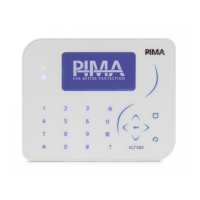Chap. 8: CMS & Communications
33
Chap. 8 CMS & Communications
The
CMS & Communications
menu includes the following sub-menus:
1) Monitoring Stations. See below.
2) PIMA Cloud. See section 8.2, on page 36.
3) General Settings. See section 8.1.3, on page 35.
4) Telephone Settings. See section 8.4, on page 36.
5) Network Settings. See section 8.5, on page 37.
6) GSM/GPRS Settings. See section 8.6, on page 37.
8.1 Monitoring Stations
System Configuration
CMS & Communications
Monitoring Stations
The
Monitoring Stations
menu includes the following sub-menus:
1) CMS
1-2. See below.
2) Radio. See section 8.1.2, on page 34.
3) Custom Zones Report. See section 8.1.3, on page 35.
8.1.1 CMS 1-2
System Configuration
CMS & Communications
Monitoring Stations
CMS 1-2
The
CMS 1-2
menu includes the following sub-menus:
1) Comm. Paths. See below.
2) Event Reporting: see page 34.
3) CMS Name: user text, up to 16 characters.
4) CMS Lock Code: set a code to the definitions of this CMS. See Appendix D, on page 52.
Comm. Paths
System Configuration
CMS & Communications
Monitoring Stations
CMS 1-2
Comm. Paths
The
Communication Paths
menu includes the following sub-menus:
1) Telephone (PSTN). The parameters in this menu are:
For each defined partition, set an ID number. If you only set partition 1’s
number, it will serve all other partitions.
Set up to 4 numbers of the CMS.
Select the CMS PSTN protocol from the list. The options are: ContactID,
PID, SIA
9
, and NPAF.
A parameter required by the NPAF protocol only. Consult the CMS.
1) Handshake Wait: how long the control panel will wait for a
Handshake, before disconnecting the call and redialing. Change the
default time only if necessary, for example if the Handshake signal for
the selected protocol is not the first one sent by the CMS receiver.
Range: 20-250 seconds.
Central Monitoring Station
Consult with PIMA support team regarding the functionality of the PID and SIA protocols

